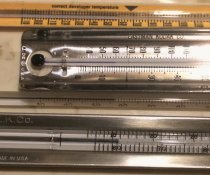Paul Verizzo
Member
I tried searching on the intertubes with both catalog and part number and got no hits. Lots of noise....
It's Kodak part number 491539, catalog number 112 2167. A glass tube, no metal backplate, a bit less than a foot long. Fahrenheit only, black fluid in the glass which has the temperature markings.
The markings allow, at best, a half degree of interpolation. Nevertheless, I'd like to know what Kodak claimed.
Thanks!
It's Kodak part number 491539, catalog number 112 2167. A glass tube, no metal backplate, a bit less than a foot long. Fahrenheit only, black fluid in the glass which has the temperature markings.
The markings allow, at best, a half degree of interpolation. Nevertheless, I'd like to know what Kodak claimed.
Thanks!













